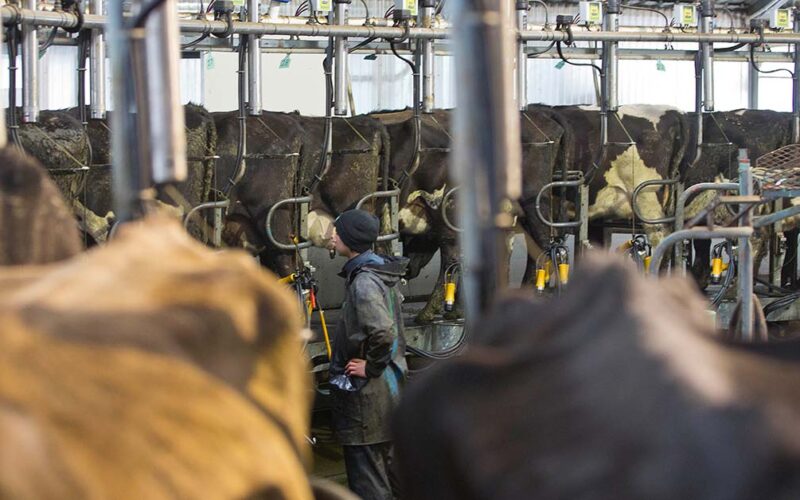By Alexandria Winning-Browne, NZX dairy analyst
Dairy Australia has released their June Milk Production report, highlighting a further decline for the final month of the 2021-22 season. Australia’s June milk production declined a whopping 9.2% year on year, bringing the season’s total production to a decline of 3.9%, with 8509 million litres produced. This is the largest monthly decline for the whole season, with June and May both reporting significant declines with flash floods and extreme temperatures having impacted the country in early winter. This is the third La Niña in a row for the nation, and while the weather has helped keep bushfire risk low, it has impacted pasture and grain and feed harvests.
The season saw production declines across all major dairy producing regions, with declines of 0.3%, 4.1%, 3.4%, 1.8%, 5.9% and 7.7% for New South Wales, Victoria, Queensland, South Australia, Western Australia, and Tasmania. Despite only a 0.3% decline for the season out of NSW, the region saw its second-largest fall for the season in June with a massive 10.3% decline, on top of the season’s largest decline of 10.4% the month prior. This is no surprise as extreme weather has continued to batter the region. As the nation’s second-largest dairy producing region, this had a huge hit on national milk production.
Despite the season’s declines, dairy exports have increased with exports sitting 0.4% higher season to date from a volume basis and 9.9% higher season to date from a value basis. Season to date, Australia exported 487,046mt of dairy, totalling a massive AU$2.05 billion.
Milk powders and cheese drove these increases with season to date increases of exports of whole milk powder (WMP), skim milk powder (SMP), and cheese by 14%, 11%, and 2%. On the other hand, fats and whey saw declines with anhydrous milk fat (AMF), butter, and whey declining 7%, 24%, and 11% season to date.
June’s export figures reflected May and June’s falls in production with a decline of 3.9% YoY from a volume basis and a decline of 0.9% YoY from a value basis. By commodity, SMP, cheese, and whey reported positive results, up 19%, 3% and 78% YoY in June. On the other hand, WMP, AMF, and butter reported declines of 44%, 46%, and 37% YoY in June.
While production declines were anticipated, a 3.9% decline out of Australia on top of New Zealand and Europe also reporting declines is painting a pretty dire situation for global milk supply. While the US and Argentina are still reporting increases, global droughts impacting Europe and China are expected to further add to food shortage concerns and the buffer that Argentina and the US could provide is becoming less and less reassuring. With supply declining, we are seeing prices rebound and domestic prices within Australia are reflecting this.
What happened last week in dairy?
The third Global Dairy Trade (GDT) Pulse auction has resulted in an increase in the price of WMP, with the only contract period sold, C2, lifting 0.89% at US$3415/t.
Like the last Pulse event, demand was a large factor, with the auction lasting 8 rounds, taking 23 minutes, and selling all 1000mt on offer.
The dairy futures market has been pushing for this kind of response from the physical market over the last week. Futures prices have skyrocketed over the last couple weeks, with increases across both milk powders, butter, and milk price futures.
WMP futures predicted an increase at last week’s Pulse, with increases across all contracts on offer. However, the latest response to the Pulse auction has continued to push for increases from the physical market. The front eight contracts have shifted upwards between 1.4% and 5.7%, with a range of US$3550/t in the September contract through to US$3825/t in contracts February through April. The October contract still sits US$245/t above the Pulse events, anticipating an increase of 8.4% at the next GDT auction to align with futures pricing.
SMP futures have followed suit with the front eight contracts shifting upwards between 1.1% and 7.7%, with the front contract sitting at US$3650/t and sitting within a range of US$65/t across all contracts. Like WMP, C2 now sits well above the last GDT auction, with the market needing an increase of 6.2% at the next auction to align with the Derivatives market.
In addition, butter futures are positive across the board, while the front AMF contract is also positive, however untraded in the back seven contracts.
Milk price futures have also seen a huge increase of 29 cents in the 2023 contract, sitting at US$9.60/kg MS at the time of writing, with a bid of US$9.65/ kgMS – indicating the market expects commodity prices to keep pushing up.
In short, the last few months of lulls in commodity prices appear to have taken a turn, and with short global production, supply appears to be pushing demand.










